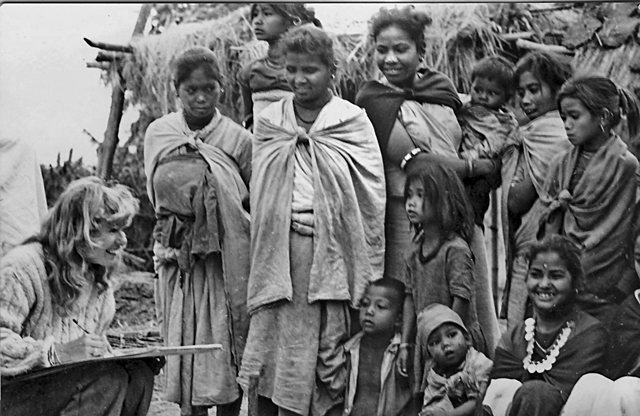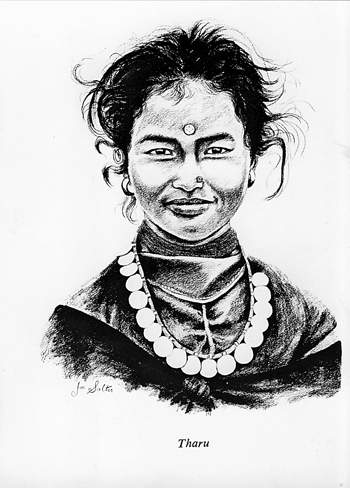The story of the person behind the persona of Jan Salter

Sometime in the 80s, a British woman from Southampton travelled to Jakarta. While she was there, she attended an art show by the great Indonesian artist Affandi. The woman, an aspiring artist, wanted to learn from him. After she spent some time with him, Affandi told the woman that she would become more than an ordinary painter.
A decade later, on a summer afternoon, a friend visited the woman, who was now living in Kathmandu. Both of them sat down in the sitting area of the artist’s apartment sipping tea. “Oh wait, you look so lovely today, let me paint you,” said the artist to her long-time friend.
“So Jan (Salter) brought her colors and a canvas to the room and started painting. It took her two-three sessions to complete the portrait,” says Rupy Singh, a long-time friend of Jan’s, standing in front of the same portrait at Jan’s retrospective exhibition in Kathmandu.

Painting someone like Singh in the comfort of her apartment was a luxury for the artist, considering what she had to go through to draw and paint. “I would go to Boudhha or Pashupatinath during the festive seasons, take out my canvas and my colors and start drawing,” recalls Jan. “Painting a landscape is very easy, all you need to do is go to a quiet place and start your work. But drawing people is not that easy.
“When I was drawing, after sometime, I would see little scribbles on the canvas. Painting was much more difficult. People used to surround me and play with my expensive oil paint. They would stand tightly near me; I could hardly move!”
“Imagine being the only white woman in the middle of a crowd in Kathmandu back in the 70s or even 80s,” she says. After some time even the shopkeepers in Boudhanath started recognizing her and told her not to start her work in front of their shop.
 They knew that if she started working in front of their shop, a curious crowd would follow, and their customers would not be able to see the shop. “In those days, we didn’t have digital cameras. So drawings were the only ‘instant’ pictures people could see of them.” When she would travel from village to village, people from the previous village would go to the next village yelling, “The artist is coming!”
They knew that if she started working in front of their shop, a curious crowd would follow, and their customers would not be able to see the shop. “In those days, we didn’t have digital cameras. So drawings were the only ‘instant’ pictures people could see of them.” When she would travel from village to village, people from the previous village would go to the next village yelling, “The artist is coming!”
?That wouldn’t deter Jan from doing what she loved doing the most. Over time, she would trek extensively around Nepal and capture through her pencil sketches people from different ethnic groups. Gradually it would take the shape of a collection. In 1996, the collection was published as a book, Faces of Nepal, with text by Dr Harka Gurung. Her other famous sketches and paintings were showcased at a retrospective called ‘All our Daughters’: paintings of girls who were victims of trafficking.
“Look at the eyes in the faces she has drawn,” says artist Ratan Rai, whose portrait was one of the many showcased at the event. “The eyes give life to her drawings,” he says. Rai, who has seen Jan evolve as an artist, says the self-taught artist has humbled many academically trained ones.
While all this was going on in the life of Jan Salter the artist, a lot was going on in the life of Jan Salter, a caring and passionate woman. In the 70s, she had decided to become the guardian of a young Newar boy, Premlal, who lived near Basantapur. Then there was a Japanese man whom she had fallen in love with while he had come to work as a volunteer in Kathmandu. According to her friends, she travelled to Japan many times to meet him. But things did not work out for the couple as his Samurai family objected to their relationship. “This is a personal side of my life that I don’t wish to share,” she says.
Sharing her happiness and love was what Jan does to people around her, says Singh. She says Jan always preferred to live alone. “She continues to live a humble life.”
Singh remembers a gardener who used to work for Jan. “Well, Jan sent her gardener to live with her brother in the UK. But he fell really ill during that time. Jan put in all her effort to help him recover.”
It is not just people that she is fond of. Her friends say they have often found her feeding local dogs on the streets near her home. During her visit to Jaipur, India, she found that the city was able to deal with the stray dog population without poisoning them. She wanted to do the same in Kathmandu.
In 2004, at 68 years of age – when most people retire, she started the KAT (Kathmandu Animal Treatment) Center in Budhanilkantha to help control the population of stray dogs. When she started KAT Centre to replicate what was being done in Jaipur, little did she know that this would mean that she would not be able to paint the way she used to.
Artist Ratan Rai, whose portrait was also on display at the Retrospective, says it was the KAT Centre that forced her to stop drawing. “She was totally exhausted by the amount of work she had to do,” he remembers. On top of that she was diagnosed with Parkinson’s.
There are good days and bad days with Parkinson’s, says Jan, who is still actively engaged with KAT Center, sitting on a sofa in the same room where she painted Singh’s portrait. The color of her blue eyes have faded.
“Well, she is no ordinary artist. I guess no country can boast of an artist who has drawn faces of people from groups as diverse as us Nepalis,” says Singh.










